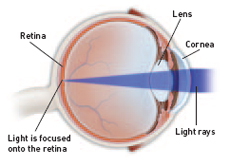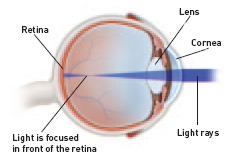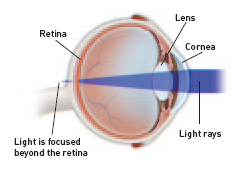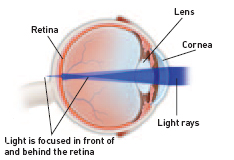Eye Services
Dr. Benson's practice emphasis is on treatment of glaucoma, diabetic eye dises, macular degeneration, dry eye, and other eye problems in addition to providing quality eye care to all ages.

Meet Dr. Benson
Dr. Benson is both types of eye doctors: Optometrist AND Ophthalmologist. Practicing with the motto, "Caring for you, not just your eyes," he has been attending to his patients for more than 25 years.

Frequently Asked
What is an ophthalmologist?
Why should I see an ophthalmologist?
How often should I see an ophthalmologist?
Get these answers and more.

Refractive Errors
What are refractive errors?
In order for our eyes to be able to see, light rays must be bent or refracted by the cornea and the lens so they can focus on the retina, the layer of light-sensitive cells lining the back of the eye. The retina receives the picture formed by these light rays and sends the image to the brain through the optic nerve. A refractive error means that due to its shape, your eye doesn’t refract the light properly, so the image you see is blurred. Although refractive errors are called eye disorders, they are not diseases.
 |
In a normal eye, the cornea and lens focus light rays on the retina. |
What are the different types of refractive errors?
MYOPIA (NEARSIGHTEDNESS)
A myopic eye is longer than normal or has a cornea that is too steep. As a result, light rays focus in front of the retina instead of on it. Close objects look clear but distant objects appear blurred.
|
In myopia, the eye is too long or the cornea is too steep. Distant objects appear blurry because images focus in front of the retina instead of on it. |
 |
Myopia is inherited and is often discovered in children when they are between ages 8 and 12 years old. During the teenage years, when the body grows rapidly, myopia may become worse. Between the ages of 20 and 40, there is usually little change. If the myopia is mild, it is called low myopia. Severe myopia is known as high myopia. If you have high myopia, you have a higher risk of detached retina. Your ophthalmologist (Eye M.D.) should discuss the warning signs of retinal detachment with you if you are in this risk category. If the retina does detach, a surgical procedure is the only way to repair it. It is important to have regular eye examinations by an ophthalmologist to watch for changes in the retina.
HYPEROPIA (FARSIGHTEDNESS)
A hyperopic eye is shorter than normal or has a cornea that is too flat. As a result, light rays focus beyond the retina instead of on it. Most children are farsighted, yet they do not experience blurry vision. With focusing (accommodation), children’s eyes are able to bend the light rays and place them directly on the retina. As long as the farsightedness is not too severe, hyperopic children will have clear vision for seeing objects at a distance and up close. As we get older we slowly lose our ability to focus, and adults with hyperopia may experience increased difficulties with reading
or other tasks up close.
 |
|
In hyperopia, the eye is too short. Close objects appear blurry because images focus beyond the retina. |
Like nearsightedness, farsightedness is usually inherited. Babies and young children tend to beslightly hyperopic. As the eye grows and becomes longer, hyperopia lessens.
ASTIGMATISM (DISTORTED VISION)
The cornea is the clear front window of the eye. A normal cornea is round and smooth, like a basketball. If you have astigmatism, the cornea curves more in one direction than in the other, like a football.
| In astigmatism, the cornea is uneven. Images focus in front of and beyond the retina, causing both close and distant objects to appear blurry. |  |
Astigmatism distorts or blurs vision for both near and far objects. It’s almost like looking into a fun-house mirror in which you appear too tall, too wide, or too thin. It is possible to have astigmatism in combination with myopia or hyperopia.
PRESBYOPIA (AGING EYES)
When you are young, the lens in your eye is soft and flexible. The lens of the eye changes its shape easily, allowing you to focus on objects both close and far away. After the age of 40, the lens becomes more rigid. Because the lens can’t change shape as easily as it once did, it is more difficult to read at close range. This normal condition is called presbyopia. You can also have presbyopia in combination with myopia, hyperopia, or astigmatism.
How are refractive errors corrected?
Eyeglasses or contact lenses are the most common methods of correcting refractive errors. They work by refocusing light rays on the retina, compensating for the shape of your eye. Refractive surgery is also an option to correct or improve your vision. These surgical procedures are used to adjust your eye’s focusing ability by reshaping the cornea, or front surface of your eye. There is not adequate scientific evidence to suggest that eye exercises, vitamins, or pills can prevent or cure refractive errors.
EYEGLASSES
Wearing eyelasses is an easy method to correct refractive errors. They can also help protect your eyes from harmful light rays, such as ultraviolet (UV) light rays. A special lens coating that creens out UV light is available. Glasses or goggles made of protective lens material (polycarbonate) should be used for sports and all hazardous activities. All children and adults who have one poorly seeing eye should wear protective polycarbonate lenses at all times to protect their “good” eye. Bifocals are eyeglasses used to correct presbyopia. They have a correction for reading on the bottom half of the lens and another for seeing at a distance on the top. Trifocals are lenses with three different lens corrections in one set of eyeglasses. If you don’t need correction for seeing at a distance, you can receive a prescription for reading glasses or buy them over the counter to correct presbyopia. No exercise or medication can reverse presbyopia. You will probably need to change your prescription from time to time between the ages of 40 and 60 because your lens will continue to lose flexibility.


